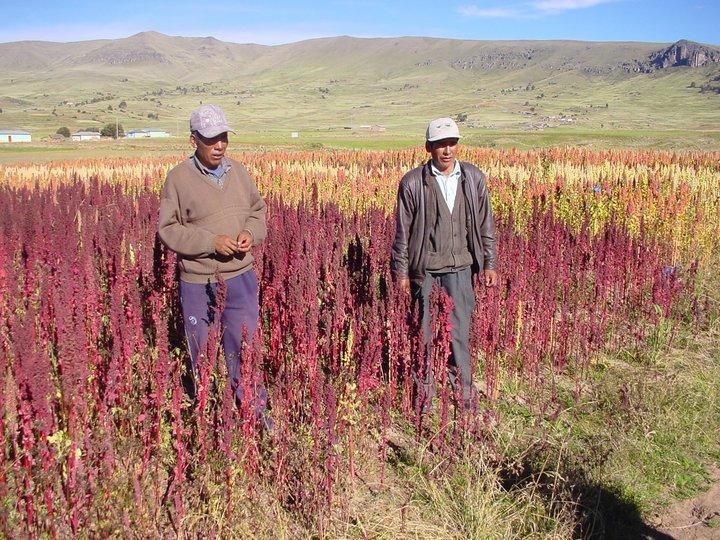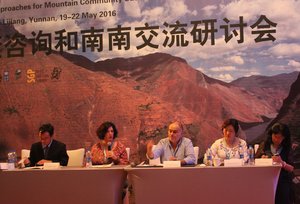Learning from the Andeans and safeguarding crop diversity in mountain communities in China

International workshop brings authorities together to discuss how landscape approaches can be key for climate adaptation and poverty alleviation in China.
Bioversity International’s scientists, Ronnie Vernooy and Zhang Zongwen, report from China about a workshop held last month in the province of Yunnan, where one of Bioversity International’s successful efforts to promote community-led landscape management approaches was showcased as an example that can be applied in countries with important mountainous areas, such as China.
China has increasingly realized the importance of biological and cultural diversity in its ecological civilization strategy and green social transition. Although the country has achieved significant poverty reduction in the last decade, levels still remain at about 200 million. Yunnan, where the event was held, still has a population of 5,600,000 living in poverty, mainly ethnic people in mountain communities. At the same time, it is well known for its rich biological and ethnic diversity, diversified landscapes, and valuable bio-cultural heritage. The existing community-based actions for landscape management, poverty reduction and climate change adaptation in Yunnan and beyond, can provide important learning cases for South-South collaboration – a large program that has been granted new funding for climate change at the UNFCCC COP21- at both policy and action levels.
Since 2009, Bioversity International has been working in many countries to bridge research for development and policy making to mainstream community-based biocultural landscape approaches by designing specific incentive schemes to conserve priority threatened species, while also supporting indigenous farmer livelihoods and existing community institutions of collective action. Such incentives are important taking into account that many varieties may not currently have market potential, yet can still contain valuable and often unexplored genetic potential to help future-proof our food systems.
The Policy Consultation and South-South Exchange Workshop, held in Lijiang and Stone village, aimed to explore and promote community-led landscape approaches as critical tools for sustainable development, climate adaptation and poverty alleviation, The workshop brought together staff from UN agencies, international and Chinese research organizations, and NGOs. The event was coordinated by the Center for Chinese Agricultural Policy – the country’s leading agricultural policy research organization.
Representatives from the International Network for Mountainous Indigenous People from China, Central Asia, Nepal and Peru were also present to strengthen the adaptive capacity of mountain communities and share key methods for adaptation. They learned and discussed about community-based irrigation systems, community seedbanks, participatory plant breeding, community-supported agriculture, and the development of biocultural products and services.
 Gabriel Quijandría Acosta, Peru’s vice-minister of Strategic Development of Natural Resources, Ministry of the Environment, highlighted that investing in biocultural landscapes to achieve the Sustainable Development Goals requires that key ministries work together to mainstream climate change into all government planning and budgeting. He also emphasized “it is imperative that new policy measures be designed, tested and assessed that allow for effective government investments”.
Gabriel Quijandría Acosta, Peru’s vice-minister of Strategic Development of Natural Resources, Ministry of the Environment, highlighted that investing in biocultural landscapes to achieve the Sustainable Development Goals requires that key ministries work together to mainstream climate change into all government planning and budgeting. He also emphasized “it is imperative that new policy measures be designed, tested and assessed that allow for effective government investments”.
Acosta showcased Bioversity International’s pilot work on payments for agrobiodiversity services (known as PACS) in Peru, which aims to create cost-efficient strategies to conserve priority endangered species and also improve indigenous farmer livelihoods. Smallholder farmers, especially those on marginal lands like in the Andes, are often much more interested in minimizing risk than in maximizing productivity. They need to feed themselves and their families. For example, maintaining a variety of different crops can reduce the risk of complete loss in the event of harvest failure. A particular species/variety may also be socially and culturally valuable. Yet maintaining crop diversity at the 'on farm' level generates benefits at the local, national or even global level. For that reason, Bioversity International is working with partners in Peru for the recognition of the value of farmers’ work in maintaining such agricultural biodiversity, and the provision of positive incentives that adequately compensate them for doing so - a form of Payment for Ecosystem Services.
This novel policy measure, still under development, is now being scaled-up by the Ministry of Environment, Agriculture and Regional Governments to cover more crops and larger areas of the country. Additional support is being sought through the design of public investment projects for agrobiodiversity conservation and use that will be able to qualify for larger-scale funding from the Ministry of Economy and Finance. Public food procurement programs are also being encouraged to fulfill their mandates and support small farmers by using their significant purchasing power to generate demand for crop genetic resources identified as a priority for conservation and use.
Ronnie Vernooy, Bioversity International’s genetic resources policy specialist spoke at the Lijiang event about the different roles that local institutions, such as farmer associations, community seedbanks and cooperatives, can play in connecting local level action with policy processes. Zongwen Zhang, from Bioversity International’s Beijing office, presented the challenges and opportunities of implementing globally important agricultural heritage sites in China.
The workshop findings will be used to inform relevant policy processes, including the UNFCCC COP22 in Marrakesh in November 2016.
Photo top: Farmers standing in front of the quinoa varieties that they had planted as part of the PACS scheme in Peru. Credit: Bioversity International/Adam G. Drucker
Photo bottom: Gabriel Quijandría Acosta at the Policy Consultation and South-South Exchange Workshop in China. Credit: Bioversity International/Ronnie Vernooy
